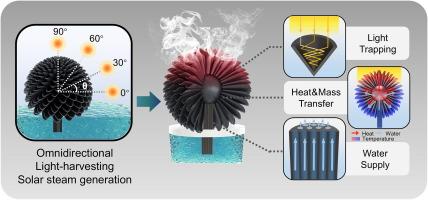Pompon dahlia-inspired 3D architecture for omnidirectional light harvest and high-efficiency solar steam generation
IF 13.3
1区 工程技术
Q1 ENGINEERING, CHEMICAL
引用次数: 0
Abstract
3D solar-driven interfacial evaporators have emerged as a promising technology to address freshwater scarcity, offering a sustainable means of providing affordable drinking water for off-grid areas. However, integrating key characteristics such as effective light absorption and photothermal conversion, optimized thermal management, efficient water transport structures, and resistance to salt scaling and omnidirectional light-harvesting into a single device remains challenging. Here, we present a novel bio-inspired solar evaporator design derived from the unique hierarchical structures of the Pompon Dahlia (PPD). The resulting evaporator after graphitization features conical cavities and star-like topological structures that enhance light absorption as well as heat and mass transfer, enabling efficient and stable solar evaporation across a broad salinity range, and the interesting 3D spherical geometry ensures minimal performance variation despite changes in solar elevation angles. The evaporator demonstrates high steam generation performance with an evaporation rate of 2.25 kg m2 h−1 and an efficiency of 97.2 % under 1-sun irradiance. Within 10-h operation, no salt deposition occurs at a salinity of 5 wt%, and only 11.1 % salt coverage appears on the evaporator in high-salinity brine (10 wt%), with an acceptable performance degradation of 8.8 %. Notably, even at an extremely solar elevation angle of 0°, a maximum performance decrease is limited at 15 %. This bio-inspired design, inheriting the natural hierarchical structure of PPD, paves the way for the development of efficient and reliable solar evaporators capable of operating across a wide range of salinities throughout all daylight hours

求助全文
约1分钟内获得全文
求助全文
来源期刊

Chemical Engineering Journal
工程技术-工程:化工
CiteScore
21.70
自引率
9.30%
发文量
6781
审稿时长
2.4 months
期刊介绍:
The Chemical Engineering Journal is an international research journal that invites contributions of original and novel fundamental research. It aims to provide an international platform for presenting original fundamental research, interpretative reviews, and discussions on new developments in chemical engineering. The journal welcomes papers that describe novel theory and its practical application, as well as those that demonstrate the transfer of techniques from other disciplines. It also welcomes reports on carefully conducted experimental work that is soundly interpreted. The main focus of the journal is on original and rigorous research results that have broad significance. The Catalysis section within the Chemical Engineering Journal focuses specifically on Experimental and Theoretical studies in the fields of heterogeneous catalysis, molecular catalysis, and biocatalysis. These studies have industrial impact on various sectors such as chemicals, energy, materials, foods, healthcare, and environmental protection.
 求助内容:
求助内容: 应助结果提醒方式:
应助结果提醒方式:


